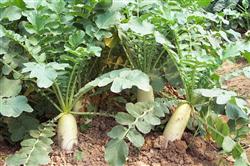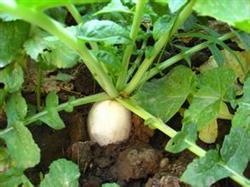Cultivation and Management techniques of Carrot sowing in Spring

1. Determine suitable sowing time. Carrot is easy to bolt when it is sown early in spring, but when it is sown late, the fleshy root will be expanded at a high temperature above 25℃, resulting in a large number of abnormal roots. The suitable temperature for fleshy root expansion of carrot is 18~25℃. According to production experience, under the premise of selecting bolting resistant spring sowing varieties, sowing can be carried out at 10℃ daily average temperature and 7℃ night average temperature. South China can be sown in early March. 2. Soil preparation, fertilization and seed soaking for germination. Carrot is a root vegetable crop, should choose deep soil, fertile soil, irrigation and drainage of good sandy loam or loam. Deep ploughing and fine harrowing before sowing, with tillage depth not less than 25 cm. Combined with ploughing, 5000 kg of decomposed farm manure, 15 kg of phosphorus, potassium and quick-acting nitrogen fertilizer were applied per mu. Carrot seeds are not easy to absorb water and ventilate, coupled with low ground temperature in spring sowing, resulting in slow germination and emergence of seeds. In order to promote early germination and emergence, seed soaking should be carried out before sowing. The method is to soak seeds in warm water at 30~35℃ for 3~4 hours, remove them and pack them with wet towels or bags to keep them moist, place them at 25~30℃ for germination for 3~4 days, stir and wash regularly, and sow them with wet sand after 80%~90% of seeds are exposed. After sowing evenly covered with a thin layer of soil, covered with plastic film, can also be used instead of straw or grass. 3. Field management. The soil should be kept moist immediately after sowing and watered immediately or [after being shielded] to create conditions conducive to germination and emergence of seeds. The mulch should be removed in the windless morning after the seedlings have emerged. During seedling period, seedlings were planted twice, the first time was carried out when 1~2 true leaves were formed, and inferior seedlings, weak seedlings and over-dense seedlings were removed; the second time was carried out when 3~4 true leaves were formed, and seedlings were fixed after thinning, and the spacing between fixed seedlings was 9 cm and the row spacing was 15~18 cm. Intertillage and weeding are the key to high yield of carrots. In addition, pay attention to cultivating soil during intertillage to prevent the top of fleshy roots from exposing the ground to form green shoulders. To make carrot yield, whole growth period should water topdressing 2~3 times. The first time is carried out 5~7 days after seedling determination, and ammonium sulfate is applied with 3 kg and phosphorus and potassium fertilizer are applied with 3 kg per mu in combination with watering. For the second time, at the initial stage of 8~9 true leaves and fleshy root expansion, i.e. the period when water and fertilizer are most needed, ammonium sulfate 7.5 kg and phosphorus and potassium fertilizer 3.5 kg are applied per mu in combination with watering. 4. Harvest by stages. Most spring carrots in Guangdong are sown in early March and harvested in early June. When they mature, their leaves no longer grow, no new leaves are seen, and the lower leaves turn yellow. Harvesting too early or too late will affect the commodity characteristics of carrots, thus affecting the yield. If there is 0~3℃ cold storage, storage after harvest, can supply the whole summer.
- Prev

How to use medicine for carrot black spot disease
(1) symptoms. Stems, leaves and petioles can all be infected. Leaf infection mostly starts from the tip or edge of the leaf, showing irregular dark brown to black spots, the surrounding tissue aggravates discoloration, black mildew layer grows on the spots with high humidity, serious spots converge, the leaf margin rolls up, and the leaves wither early. The stem is infected, and the disease spot is oblong dark brown.
- Next

Key points of cultivation techniques of spring radish
Choose a good seed. Select varieties with short growth period, strong cold tolerance, late bolting and not easy to hollow. At present, there are many radish varieties suitable for spring cultivation, such as Baiyuchun, Chunbaiyu, Spring radish 9646 and Changchun big root. Prepare the land to make beds. Choose the land with loose soil and apply 3000 mu of rotten organic fertilizer.
Related
- Where is it suitable to grow horseradish in China? it is expected to see the middle altitude horseradish in Alishan.
- How to prevent tomato virus disease reasonably? (Control methods included)
- Many people like to plant towel gourd on the balcony. What are the main points of this method and management?
- What crops can chili peppers be mixed with?
- Fertilization techniques and matters needing attention in Tomato
- What are the grafting techniques for peach seedlings in spring?
- Harm and control methods of root swelling disease of Chinese cabbage
- What are the pests of sweet potatoes? How to prevent and cure it?
- Symptoms, causes and Control methods of navel Rot in Tomato
- The cause of "Cucumber rotten bibcock" in Farmers' planting Cucumber and its Control Plan

